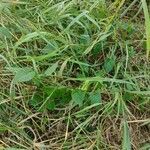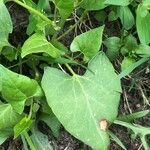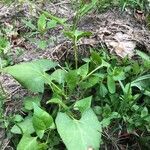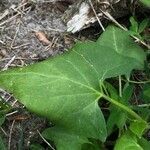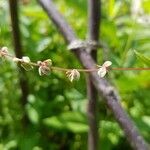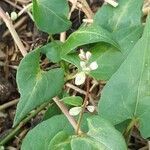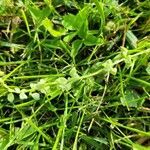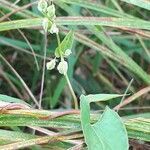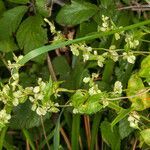Annual, climbing, convolvulus-like herb, glabrous or finely puberulent, with slender twining stems and slender taproot. Petiole very slender, to 6 cm long. Lamina (1)-2-9 × (0.5)-1-6 cm, ± ovate-sagittate, entire; base shallowly to deeply cordate; apex acute, cuspidate or acuminate. Ochreae to c. 5 mm long, obliquely truncate, soon lacerate. Fls in terminal or axillary racemes with a slender, puberulent peduncle or in fascicles, often in axils of all but the basal lvs, ± pale green, scentless. Bracts generally = or > pedicels, membranous except for green keel. Pedicels short at anthesis, 1.5-3-(5) mm long at fruiting, articulate above middle, winged in upper part. Perianth 1-3 mm long, broad-ovate to broad-elliptic, moderately accrescent, the 3 outer segments with acute green keel and often white margins. Stamens not enclosed in perianth segments; filaments glabrous. Valves of fr. 4-6 mm long, glabrous or finely puberulent, the outer with prominent greenish white margin. Nut 3-4 mm long, black, finely granular; ribs obtuse.
Herbs annual. Stems twining, to 1-1.5 m, striate, papillate, branched at base. Petiole 1.5-5 cm; leaf blade small papillose abaxially, base cordate, margin entire, apex acuminate; ocrea short, membranous, oblique, not ciliate. Inflorescence axillary, racemose, interrupted; bracts narrowly ovate, apex acute, each 2-4-flowered. Pedicels longer than bracts, slender, margin white; tepals narrowly elliptic, unequal in size, outer 3 larger and keeled or narrowly winged on abaxial surface, slightly accrescent in fruit. Stamens 8. Styles 3, very short, stipitate. Achenes included in persistent perianth, black, opaque, ellipsoid, trigonous, 3-4 mm, finely granular. Fl. May-Aug, fr. Jun-Sep.
It is a climbing plant. It grows as an annual. The stems twine. The leaves end abruptly and are heart shaped. The leaf stalks are long. The flowers are white. They are in loose clusters at the ends of the plant. The fruit are a dull black colour.
Flowers pedicellate, in whorls of 3–6 in the axils of bracts; whorls arranged in axillary lax pedunculate or subsessile racemes; pedicels up to 10 mm long, scabrid, articulate above the middle; bracts inconspicuous.
Leaf lamina 2–7 × 2.5–5 cm, ovate to cordate, acuminate to the apex, sagittate at the base, entire, smooth on upper surface; petiole up to 2 cm long, scabrid or papillose.
Stems sometimes reddish-brown, angular, glabrous, scabrid or papillose.
Perianth greenish, 2–5 mm long; the outer segments keeled in fruit.
Ovary 1–3 mm long; stigmas capitate, entire on the margin.
A scrambling or climbing annual herb, up to 1.20 m tall.
Nut dull, black, finely granulate, 2.5–4(5) mm long.
Stamen filaments subulate, naked.
Ocrea membranous.

